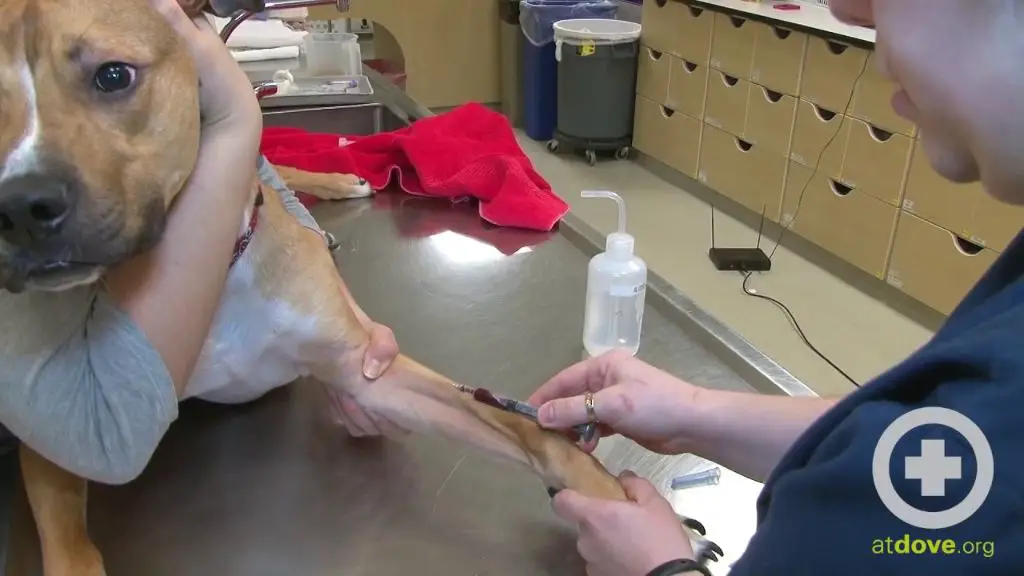Introduction
Seizures are relatively common in dogs, though the exact prevalence is unknown. A seizure occurs when there is abnormal electrical activity in the brain, causing involuntary muscle activity and possible loss of consciousness. Seizures may be isolated incidents, or they can indicate an underlying chronic condition like epilepsy. There are many potential triggers that can cause seizures in dogs, including both inherited and acquired causes.
This article will provide an overview of some of the most common triggers that can lead to seizures in dogs, including idiopathic epilepsy, metabolic disorders, infections, toxins, head trauma, brain tumors, medications, and genetic conditions. Recognizing the causes and risk factors for seizures is important for dog owners and veterinarians when it comes to prevention, treatment, and management.
Idiopathic Epilepsy
Idiopathic epilepsy is the most common cause of seizures in dogs. As the name suggests, idiopathic means the cause is unknown. With idiopathic epilepsy, there is no identifiable underlying cause for the seizures despite extensive diagnostic testing. It is believed there is a genetic component, as idiopathic epilepsy frequently occurs in certain breeds like Belgian Tervurens, Australian Shepherds, Beagles, Border Collies, German Shepherds, Golden Retrievers, and Labrador Retrievers. The average age of onset is between 1 and 5 years old. Dogs with idiopathic epilepsy experience recurrent seizures, but are otherwise normal between episodes. The seizures are generalized, meaning they involve the whole brain. Idiopathic epilepsy cannot be cured, but the seizures can often be well-controlled with anti-seizure medications.
Brain Tumors

Tumors in the brain can press on brain tissues and nerves, causing abnormalities in brain activity that may trigger seizures. Primary brain tumors start in the brain itself, while secondary or metastatic brain tumors spread from cancers elsewhere in the body.
Primary brain tumors are less common but more likely to cause seizures than metastatic tumors. The most common types of primary brain tumors in dogs are meningiomas, gliomas, and pituitary tumors. These tumors often develop in middle-aged to older dogs but can occur at any age.
Brain tumor-related seizures may be partial (focal) or generalized. They can occur as the first sign of a tumor or develop later as the tumor grows. Seizures may be occasional or frequent and can worsen over time. Prompt diagnosis and treatment of the tumor itself is important to control seizures and improve quality of life.
Head Trauma
Head trauma is a common cause of seizures in dogs. Any kind of injury to the head, including concussions, can damage the brain and trigger seizure activity. Here are some ways head trauma can lead to seizures:
Brain Bleeding or Swelling: When a dog hits their head hard or sustains a serious concussion, it can cause bleeding or swelling in the brain. This puts pressure on brain tissue and interrupts normal electrical signaling between brain cells. The disrupted signaling can manifest as seizures.
Scarring: Head trauma that damages brain tissue can leave behind scar tissue as the injury heals. Scar tissue does not conduct electrical signals as well as normal brain tissue. Areas of scarring can essentially act as “short circuits” that trigger abnormal electrical firing in the brain, resulting in seizures.
Disconnecting Brain Regions: If an injury severs connective fibers between different parts of the brain, it can prevent those regions from communicating properly. This can lead to erratic electrical signals that cause seizures.
Skull Fractures: Fractured skull bones can press on or pierce brain tissue, which can physically disrupt electrical signaling and trigger seizures. Fractures may also allow blood or fluid to leak onto the brain, leading to swelling and seizure activity.
The takeaway is that physical trauma to a dog’s head poses a risk of altered brain functioning that can lower the seizure threshold. So head injuries should always be evaluated by a vet, even if the dog seems fine initially after the incident.
Metabolic Disorders

Metabolic disorders like liver disease, kidney failure, and electrolyte imbalances can trigger seizures in dogs. These conditions disrupt normal metabolism in the body, leading to a buildup of toxins that can affect brain function.
Liver disease prevents the liver from filtering toxins from the bloodstream. Toxins like ammonia and bile acids can then accumulate and cross the blood-brain barrier, interfering with neurotransmission and provoking seizure activity.
Kidney failure allows waste products like urea to build up in the blood, which can act as a neurotoxin. Electrolyte imbalances like low blood calcium, low blood sugar, and sodium/potassium abnormalities disrupt normal electrical signaling in the nervous system. This predisposes the brain to excessive electrical discharges that manifest as seizures.
Any dog with liver or kidney disease should be monitored closely for neurological symptoms like seizures. Maintaining stable electrolyte levels through proper diet and hydration can help reduce seizure risk. Overall, metabolic disorders can substantially lower the seizure threshold in dogs.
Toxins
Exposure to certain toxins and chemicals can potentially trigger seizures in dogs. Some of the most common toxin-related culprits include:
- Lead – Sources include lead-based paints, batteries, fishing sinkers, ammunition, and some plumbing materials. Lead poisoning can cause neurological symptoms like seizures.
- Pesticides – Insecticides, herbicides, rodenticides, and snail bait contain chemicals that are toxic to dogs. Pesticide poisoning is a common cause of seizures and other neurological issues in pets.
- Antifreeze – Ethylene glycol in antifreeze has a sweet taste but is highly toxic. Ingesting even small amounts can lead to life-threatening kidney failure and neurological signs like seizures in dogs.
- Metaldehyde snail bait – This common garden pesticide is extremely toxic to dogs who may eat it. Seizures are one of the symptoms of metaldehyde poisoning.
- Moldy foods – Mycotoxins from moldy/spoiled foods can also cause neurological toxicity. Keep garbage out of reach and promptly throw away moldy food or compost.
- Chemicals like cleaning products, fertilizers, or lawn treatments – Always store harmful chemicals properly out of a dog’s reach.
If you suspect your dog may have ingested a toxin, call your vet or pet poison control right away as many require rapid treatment. Prevent access to potentially poisonous substances by keeping them locked away and using pet-safe products whenever possible.
Medications

Certain medications can potentially trigger seizures in dogs. One class of drugs that may cause seizures as a side effect are antidepressants. Antidepressants like selective serotonin reuptake inhibitors (SSRIs) and tricyclic antidepressants (TCAs) affect neurotransmitters in the brain. Altering the levels of these brain chemicals can lower the seizure threshold in some dogs.
Other types of medicines that have been associated with inducing seizures in canines include non-steroidal anti-inflammatory drugs (NSAIDs), heartworm preventatives, chemotherapy drugs, and vaccines. It’s important to consult with your veterinarian about your dog’s medication regimen if you notice them having seizures. Your vet can evaluate for drug interactions and adjust dosages or switch to alternative medications that are less likely to cause seizures.
Some signs to watch for if your dog’s medicine is potentially triggering seizures include tremors, restlessness, dilated pupils, disorientation after taking the medication. If your dog has a seizure soon after receiving a new medication or dosage change, be sure to let your vet know as that medicine may need to be discontinued or adjusted.
Infection
Infections in the brain, like encephalitis, can be a cause of seizures in dogs. Encephalitis is inflammation of the brain that is often caused by viral infections. Some examples of viruses that can lead to encephalitis in dogs include distemper virus, herpesvirus, rabies virus, and West Nile virus. These viruses can infect the brain and spinal cord, leading to inflammation, brain cell death, and disruption of normal brain signaling. The inflammation and cell death in the brain alters neuronal activity and can lower the seizure threshold, making dogs more susceptible to experiencing seizures. Even after the infection itself clears, the damage done by encephalitis can leave dogs with scar tissue or other permanent changes in the brain that disrupt normal electrical signaling between neurons. This disruption then predisposes them to recurrent seizures. In summary, by infecting the brain and causing inflammation, viruses like those that lead to encephalitis can trigger acute seizures during the infection as well as chronic recurrent seizures later on due to permanent changes in brain structure and neuron functioning.
Genetic Conditions
Some dog breeds are prone to inherited genetic conditions that can cause seizures. These genetic seizure disorders are usually observed before the age of 5 years. Some breeds with an increased risk of genetic epilepsy include:
- Beagles
- Keeshonds
- German Shepherds
- Belgian Tervurens
- Collies
- Irish Setters
- Labrador Retrievers
- Vizslas
- English Springer Spaniels
- Bernese Mountain Dogs
The genetic mutation responsible varies between breeds. Some breeds have DNA tests available to screen breeding dogs. Discuss screening with your veterinarian if you plan to breed dogs prone to genetic epilepsy.
When to See a Vet

If your dog experiences a seizure, it’s important to know when to seek emergency veterinary care. Here are some signs that warrant an urgent vet visit:
-
A seizure that lasts more than 5 minutes
-
Your dog has multiple seizures within a short timeframe (known as cluster seizures)
-
Your dog’s seizure is followed by impaired consciousness, vision problems, inability to stand or walk, vomiting, or other concerning signs
-
Your dog injures itself during the seizure
-
Your dog has never had a seizure before
-
Your dog has an underlying health condition like diabetes, kidney disease, or a brain tumor
Seek immediate veterinary care if any of these situations occur, as prolonged seizures can lead to brain damage. Your vet will examine your dog and run diagnostic tests to determine the cause of the seizures.
In an emergency, your vet may administer medications to stop the seizure and support your dog’s breathing and heart rate. They will then develop a treatment plan which may include ongoing anti-seizure medications and addressing any underlying conditions.
Getting prompt veterinary care can greatly improve outcomes for dogs experiencing seizures. Don’t hesitate to call your vet or visit an emergency clinic if your dog’s seizure warrants urgent medical attention.